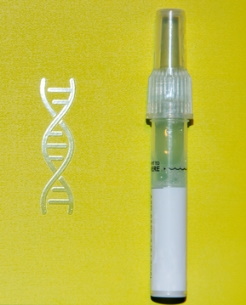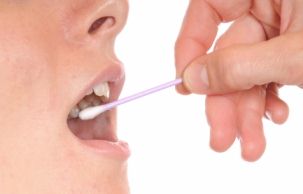- Home ›
- Genealogy & DNA ›
- Home DNA tests
Home DNA tests
Home DNA tests can be ordered over the Internet. There are several DNA testing labs now selling online direct to consumers and they all make the purchasing of a DNA home test relatively straightforward and easy.
 A home DNA test kit's spit collector.
A home DNA test kit's spit collector.But choosing a home DNA test is not quite as simple as selecting a book to take on holiday or downloading your favourite music. To avoid an expensive mistake, make sure you know before you buy just what you hope a DNA test to reveal and which of the three main tests - y-dna, mtDNA or atDNA - is most likely to achieve your aim.
Each test explores different parts of your family history, and each has its own limitations.
If you haven't done so already, I suggest you read this site's Genealogy & DNA testing page and follow some of the links to get a basic understanding of the different types of test available.
 A home DNA test kit's spit collector.
A home DNA test kit's spit collector.But choosing a home DNA test is not quite as simple as selecting a book to take on holiday or downloading your favourite music. To avoid an expensive mistake, make sure you know before you buy just what you hope a DNA test to reveal and which of the three main tests - y-dna, mtDNA or atDNA - is most likely to achieve your aim.
Each test explores different parts of your family history, and each has its own limitations.
If you haven't done so already, I suggest you read this site's Genealogy & DNA testing page and follow some of the links below to get a basic understanding of the different types of test available.
What happens after I order my home DNA test?
 With a home dna test you can swab or spit in the privacy of familiar surroundings
With a home dna test you can swab or spit in the privacy of familiar surroundingsOn receipt of your order, the laboratory will send you a DNA testing kit. It'll arrive in a neat box and will contain instructions for conducting the test itself, a return mail envelope and label, and either mouth swabs OR a rocket shaped plastic container to hold saliva.
No needles! Home DNA test kits don't expect you to inject yourself or draw blood! It'll be either a swab or a saliva test, the latter sometimes referred to as 'spit' tests.
 With a home dna test you can swab or spit in the privacy of familiar surroundings
With a home dna test you can swab or spit in the privacy of familiar surroundingsSwab test : You simply rub the swab (which may look like a 'cotton bud' such as those used for cleaning babies' ears) against the inside of your cheek. You roll the swab over your inner cheek to ensure as much saliva as possible adheres to the swab.
In so doing, the swab painlessly collects loose
skin cells known as 'buccal cells'. When you've done this, you place the swab in the provided plastic bag and, when you've completed the paperwork, it's ready to go.
Spit test : This test requires you to spit into a sealable tube. You might be surprised how much spit you're expected to deliver, but it doesn't take long. You then seal the container, complete the paperwork and pop everything back in the main envelope.
Don't be put off by the mention of paperwork. I've used that term because you do have to tell the lab who you are and some other minor details, but there's nothing difficult or invasive. You also need to keep a note of your test kit identification number, in case you need to contact the lab.
Don't be put off by the idea of paperwork. I've used that term because you do have to tell the lab who you are and some other minor details, but there's nothing difficult. You also need to keep a note of your test kit identification number, in case you need to contact the lab.
Then you sit back and await your results. Most labs keep you reasonably up to date about the progress of your test once it has arrived with them and through to the final report.
Making sense of the results
Depending on which home DNA test you have taken, you will receive notification by email that your test has been processed and your results uploaded to the lab's online database.
Your private online account will show lists of people whose dna matches your in some way. It might be that your y-chromosones show similar patterns of dna suggesting a close or distant relationship, or your automsomal test will 'match' you with 'cousins', some distant, some quite close.
It is then your job, together with the person you've matched with, to work out who your common ancestor is (the person whose dna you have both inherited). In the process you are likely to find family you didn't know of, reconnect with extended family you may have lost touch with, and, if you're dogged and lucky, reach back in time to generations whose paper trails have long been lost.
Have fun!
